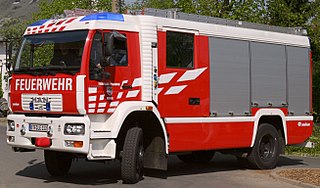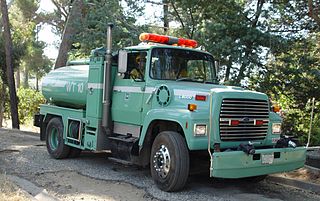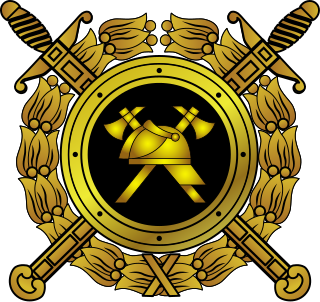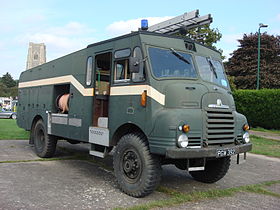
A fire engine is a road vehicle that functions as a firefighting apparatus. The primary purposes of a fire engine include transporting firefighters and water to an incident as well as carrying equipment for firefighting operations. Some fire engines have specialized functions, such as wildfire suppression and aircraft rescue and firefighting, and may also carry equipment for technical rescue.

The Los Angeles Fire Department provides emergency medical services, fire cause determination, fire prevention, fire suppression, hazardous materials mitigation, and technical rescue services to the city of Los Angeles, California, United States. The LAFD is responsible for approximately 4 million people who live in the agency's 471 square miles (1,220 km2) jurisdiction. The Los Angeles Fire Department was founded in 1886 and is one of the largest municipal fire departments in the United States, after the New York City Fire Department and the Chicago Fire Department. The department may be unofficially referred to as the Los Angeles City Fire Department or "LA City Fire" to distinguish it from the Los Angeles County Fire Department which serves the county and whose name may directly confuse people, as the county seat is the city. Another possible reason is that the city and the unincorporated county are often bordering each other and thus the two appear to be serving the same area. The department is currently under the command of chief Kristin Crowley.

A fireboat or fire-float is a specialized watercraft with pumps and nozzles designed for fighting shoreline and shipboard fires. The first fireboats, dating to the late 18th century, were tugboats, retrofitted with firefighting equipment. Older designs derived from tugboats and modern fireboats more closely resembling seafaring ships can both be found in service today. Some departments would give their multi-purpose craft the title of "fireboat" also.
Firefighting jargon includes a diverse lexicon of both common and idiosyncratic terms. One problem that exists in trying to create a list such as this is that much of the terminology used by a particular department is specifically defined in their particular standing operating procedures, such that two departments may have completely different terms for the same thing. For example, depending on whom one asks, a safety team may be referred to as a standby, a RIT or RIG or RIC, or a FAST. Furthermore, a department may change a definition within its SOP, such that one year it may be RIT, and the next RIG or RIC.
This is a glossary of firefighting equipment.

The Singapore Civil Defence Force (SCDF) is an uniformed organisation in Singapore under the Ministry of Home Affairs that provides emergency services such as firefighting, technical rescue, and emergency medical services, and coordinates national civil defence programme.
The New Zealand Fire Service was New Zealand's main firefighting body from 1 April 1976 until 1 July 2017 – at which point it was dissolved and incorporated into the new Fire and Emergency New Zealand.

The Feuerwehr is a number of German fire departments. The responsible bodies for operating and equipping fire departments are the German communities ("Gemeinden") and cities ("Städte"). By law, they are required to operate fire-fighting forces. In cities, this is usually performed by the Fire Prevention Bureau, one of the higher-ranking authorities.

The Auxiliary Fire Service (AFS) was first formed in 1938 in Great Britain as part of the Civil Defence Service. Its role was to supplement the work of brigades at local level. The Auxiliary Fire Service and the local brigades were superseded in August 1941 by the National Fire Service. After the war the AFS was reformed alongside the Civil Defence Corps, forming part of the UK's planned emergency response to a nuclear attack. It was disbanded in the UK in 1968.

A wildland fire engine is a fire engine specifically designed to assist in fighting wildfires by transporting firefighters to the scene and providing them with access to the fire, along with water or other equipment. Most commonly used by the United States Forest Service, there are multiple types of wildfire apparatus which are used in different scenarios. According to the National Fire Protection Association, if the apparatus will be used primarily for outdoor and wildland responses, then it is to be considered a wildland fire apparatus and must conform to NFPA 1906.

A wildland water tender is a specialized vehicle capable of bringing water, foam, or dry chemicals to fire trucks in the field that are engaged on the fireline. Water tenders have a large truck mounted tank that carries a minimum 1,000 gallons and up to 4,000 gallons of water. These vehicles are specifically designed for fire fighting often with four-wheel drive, rugged suspension and high wheel clearance for mountainous dirt road conditions. According to the National Fire Protection Association, if the apparatus will be used primarily for outdoor and wildland responses, then it is to be considered a wildland fire apparatus and must conform to NFPA 1906.

Russian State Fire Service is the highest fire service body of Russian Federation. A part of the Ministry of Emergency Situations since 2001, the State Fire Service is divided into the Federal Fire Service and the Fire Service of the Federal subjects of Russia.

The M970 Semi-Trailer Refueler is a 5,000-U.S.-gallon fuel dispensing tanker designed for under/overwing refueling of aircraft. It is equipped with a filter/separator, recirculation system and two refueling systems, one for underwing and one for overwing servicing. The tanker is designed to be towed by a 5-ton, 6x6 truck tractor or similar vehicle equipped with a fifth wheel. The M970 can be loaded through the bottom or through the top fill openings. A ladder is provided at the front of the semitrailer for access to the top manhole, and a 4-cylinder diesel engine and pump assembly provides self load/unload capability. The body of the refueler is a 5,000-U.S.-gallon, single compartment, stainless steel tank. The chassis is of welded steel construction and is equipped with full floating tandem axles and a manually operated landing gear. There has been talk of retiring the M970, but a suitable off-road replacement has not been found. The Marine Corps also uses R-9 and R-10 tankers, but they are not capable of off road use. The M970 is a part of the "United States Marine Corps Maintenance Center - Albany, Georgia, USA - An Integrated Enterprise Scheduling Case Study" which is working to upgrade the Semitrailer for future use.

Flexible suction hose, not to be confused with hard suction hose in U.S., is a specific type of fire hose used in drafting operations, when a fire engine uses a vacuum to draw water from a portable water tank, pool, or other static water source. It is built to withstand vacuum, rather than pressure, abrasion, and heat. Conversely, hard suction is capable of withstanding up to 200 PSIG, as well as vacuum. In the United States, it is standard equipment according to the National Fire Protection Association standards for fire engines. It is used in both structural and wildland firefighting throughout the world, and is made in various diameters and connection types.

Fire services in the United Kingdom use a variety of fire appliances, which perform a wide range of general and specialised roles and fit into several distinct categories. Contemporary fire appliances carry a multitude of equipment and firefighting media to deal with different types of emergencies ranging from fires, rescues, vehicle extrication, floods, salvage, casualty and trauma care.

Firefighting in the United States dates back to the earliest European colonies in the Americas. Early firefighters were simply community members who would respond to neighborhood fires with buckets. The first dedicated volunteer fire brigade was established in 1736 in Philadelphia. These volunteer companies were often paid by insurance companies in return for protecting their clients.
Godiva Fire Pumps was an offshoot from Coventry Climax, directed by Charles Pelham Lee, son of Leonard Pelham Lee.

The Santa Barbara County Fire Department (SBCFD) provides fire protection and emergency response services for the unincorporated areas of Santa Barbara County, California, and for multiple cities within the county. Together, these areas compose the Santa Barbara County Fire Protection District.

The electric fire engine is a fire engine with a water pump, used to distribute water to put out a fire, operated by an electric motor. Electric fire engines were first proposed in the 19th century to replace the steam pumpers used for firefighting. The electric motor was claimed to be simpler, cleaner, and faster in operation, would save money, and require less maintenance than the steam fire engine. Contemporary battery-operated models also exist.

The Penrith Museum of Fire is an Australian firefighting museum that contains heritage-listed former operating and stored for preservation fire service vehicles located in Penrith, Sydney, Australia. The provenance of the firefighting vehicles date from 1841 to 1998. The fleet of vehicles was added to the New South Wales State Heritage Register on 25 February 2013.




















